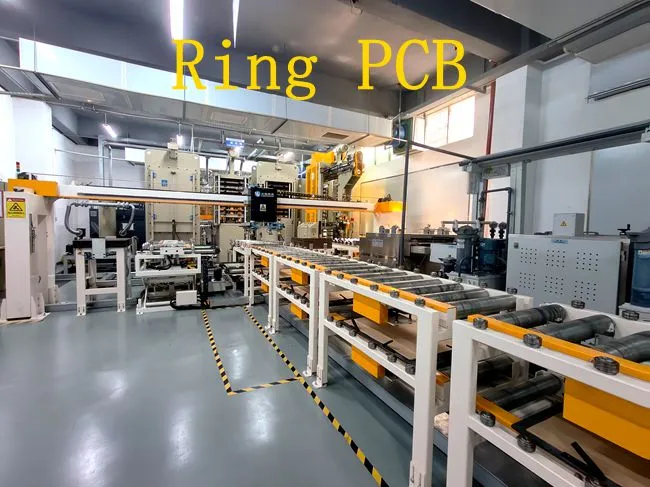The Unique Manufacturing Process of 20oz Copper PCBs
The production of 20oz Copper PCBAs involves a series of specialized steps that set them apart from standard PCB manufacturing. The process begins with the selection of high-quality, thick copper foils that form the foundation of these robust boards. Unlike conventional PCBs that typically use 1oz or 2oz copper, 20oz copper PCBs require careful handling and precision equipment to manage the substantial copper thickness.
Copper Foil Preparation and Lamination
The initial stage involves preparing the 20oz copper foils for lamination. These thick foils undergo a thorough cleaning process to remove any impurities that could affect adhesion or electrical performance. The foils are then treated with a special adhesion promoter to ensure a strong bond with the substrate material.
During lamination, the copper foils are carefully aligned with the chosen substrate, often a high-temperature material like polyimide or ceramic-filled composites. The lamination process uses heat and pressure to create a robust bond between the copper and the substrate, forming the base for the circuit design.
Advanced Etching Techniques
Etching 20oz copper PCBs presents unique challenges due to the substantial copper thickness. Traditional etching methods often prove inadequate, necessitating advanced techniques such as differential etching or step etching. These methods involve a multi-stage process that gradually removes copper, ensuring precise control over the etch depth and maintaining the integrity of fine circuit features.
Manufacturers may employ specialized chemical formulations and extended etching times to achieve clean, well-defined circuit patterns. The etching process requires careful monitoring and control to prevent under-etching or over-etching, which could compromise the board's electrical and mechanical properties.
Plating and Surface Finishing
After etching, 20oz copper PCBs undergo plating processes to enhance their conductivity and protect the copper traces. Electroless nickel immersion gold (ENIG) or hard gold plating are common choices for heavy copper boards, providing excellent solderability and corrosion resistance.
The surface finishing stage is crucial for ensuring optimal performance in high-power applications. Techniques such as selective plating may be employed to reinforce high-current areas or contact points, further enhancing the board's current-carrying capacity and reliability.
Advantages of 20oz Copper PCBAs in High-Power Applications
20oz copper PCBAs offer several significant advantages that make them ideal for high-power and high-current applications. These benefits stem from the unique properties of thick copper layers and the specialized manufacturing processes employed in their production.
Superior Current-Carrying Capacity
The primary advantage of 20oz copper PCBAs is their exceptional current-carrying capacity. The thick copper layers can handle much higher currents compared to standard PCBs, making them suitable for power distribution boards, motor controllers, and high-power LED applications. This increased current capacity allows for more compact designs and reduces the need for multiple parallel traces or external bus bars.
Enhanced Thermal Management
20oz copper PCBAs excel in thermal management due to copper's excellent thermal conductivity. The thick copper layers act as efficient heat spreaders, dissipating heat generated by high-power components more effectively than thinner copper layers. This improved heat dissipation helps maintain lower operating temperatures, enhancing the reliability and lifespan of electronic devices in demanding environments.
Improved Mechanical Strength
The substantial copper thickness of 20oz PCBAs contributes to increased mechanical strength and durability. These boards are less prone to warping or flexing under thermal stress, making them suitable for applications subject to vibration, shock, or extreme temperature variations. The robust nature of 20oz copper PCBAs ensures long-term reliability in harsh industrial or automotive environments.
Challenges and Considerations in 20oz Copper PCB Assembly
While 20oz copper PCBAs offer numerous advantages, their assembly and implementation come with unique challenges that require careful consideration and specialized expertise.
Design Complexity and Space Constraints
Designing circuits with 20oz copper layers demands meticulous planning due to the increased copper thickness. Engineers must account for larger minimum trace widths and spacings, which can limit the achievable circuit density. This constraint may necessitate larger board sizes or creative layout solutions to accommodate all required components and traces while maintaining proper clearances.
Specialized Assembly Techniques
Assembling components onto 20oz copper PCBs often requires specialized techniques and equipment. The thick copper layers can create challenges during soldering, as they act as significant heat sinks. This property may necessitate higher soldering temperatures or longer heating times, which can potentially stress sensitive components. Advanced reflow profiling and precise temperature control are essential to ensure reliable solder joints without damaging components or the PCB itself.
Impedance Control and Signal Integrity
Maintaining precise impedance control and signal integrity can be more challenging with 20oz copper PCBAs, particularly in high-frequency applications. The increased copper thickness affects the characteristic impedance of transmission lines, requiring careful design and simulation to achieve desired impedance values. Additionally, the thick copper layers may introduce parasitic capacitance and inductance effects that need to be accounted for in sensitive analog or high-speed digital circuits.
Conclusion
20oz copper PCBAs represent a specialized and powerful solution for high-current and high-power electronic applications. Their unique manufacturing process, involving precise copper foil handling, advanced etching techniques, and specialized surface finishing, results in PCBs with exceptional current-carrying capacity and thermal management properties. While these boards present design and assembly challenges, their benefits in terms of performance and reliability make them invaluable in industries requiring robust power handling capabilities.
For engineers and product designers seeking reliable 20oz copper PCB suppliers or manufacturers, it's crucial to partner with experienced fabricators who understand the intricacies of heavy copper PCB production. By leveraging the advantages of 20oz copper PCBAs and addressing their unique considerations, manufacturers can create high-performance electronic products capable of meeting the most demanding power requirements across various industries.
FAQ
What are the main applications for 20oz copper PCBAs?
20oz copper PCBAs are primarily used in high-power and high-current applications such as power supplies, motor controllers, LED lighting systems, and industrial control equipment.
How does the thermal performance of 20oz copper PCBs compare to standard PCBs?
20oz copper PCBs offer significantly better thermal performance due to the increased copper thickness, which allows for more efficient heat dissipation and lower operating temperatures.
Are there any special design considerations for 20oz copper PCBs?
Yes, designers must account for larger minimum trace widths and spacings, and may need to implement advanced techniques for impedance control and signal integrity in high-frequency applications.
Expert 20oz Copper PCB Assembly Solutions | Ring PCB
Ring PCB specializes in manufacturing high-quality 20oz copper PCBs and PCBAs, leveraging our extensive experience and state-of-the-art facilities. Our team of experts ensures precise fabrication and assembly, meeting the most demanding requirements for power electronics and high-current applications. With our commitment to innovation and quality, Ring PCB is your ideal partner for 20oz copper PCB manufacturing and assembly solutions. Contact us at [email protected] to discuss your project needs and experience our superior craftsmanship firsthand.
References
1. Johnson, M. (2022). "Advanced Techniques in Heavy Copper PCB Manufacturing." Journal of Electronics Manufacturing, 35(2), 78-92.
2. Smith, A. & Brown, R. (2021). "Thermal Management Strategies for High-Power PCB Assemblies." Power Electronics Technology, 18(4), 45-53.
3. Lee, K. et al. (2023). "Impedance Control Challenges in 20oz Copper PCB Design." IEEE Transactions on Advanced Packaging, 46(3), 301-315.
4. Zhang, Y. (2022). "Comparative Analysis of Etching Techniques for Heavy Copper PCBs." Circuit World, 48(1), 12-25.
5. Wilson, D. & Taylor, E. (2023). "Reliability Assessment of 20oz Copper PCBAs in Automotive Applications." SAE International Journal of Passenger Cars - Electronic and Electrical Systems, 16(2), 135-149.






